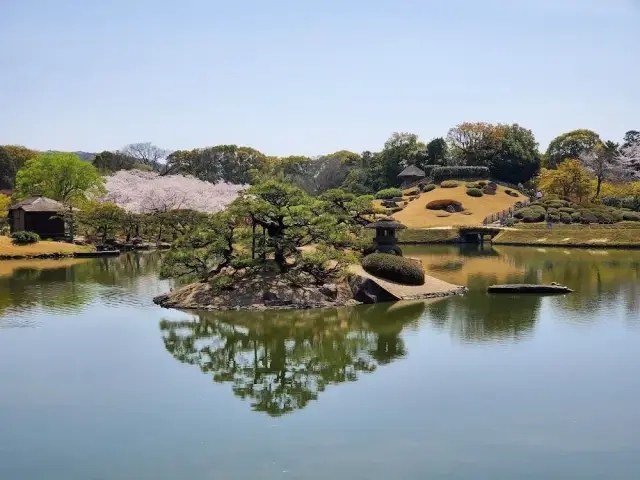https://www.dekitabi.com/itinerary/okayama-castle-sogenji-tour
Nestled in the western part of Japan’s Honshu Island, Okayama offers a rich tapestry of history, culture, and natural beauty. Whether you’re a history buff, a nature enthusiast, or simply looking for a peaceful retreat, Okayama has something to offer. Among its many attractions, Okayama Korakuen Garden, Okayama Castle, and Sogenji Temple stand out as must-see destinations. This guide will explore these iconic sites, providing insights into their history, significance, and unique features.
Okayama Korakuen Garden: A Haven of Tranquility

https://www.dekitabi.com/attraction/okayama-korakuen-garden
Okayama Korakuen Garden is widely recognized as one of Japan’s three most beautiful landscape gardens, alongside Kenrokuen in Kanazawa and Kairakuen in Mito. Established in 1700 by the Ikeda clan, the garden offers a serene escape from the bustling city life.
1. A Masterpiece of Japanese Landscape Design
Korakuen Garden spans approximately 133,000 square meters and showcases traditional Japanese landscaping principles. The garden features a large pond, expansive lawns, and meticulously curated flower beds. One of its most striking features is the “Tsukiyama” (artificial hill), which provides panoramic views of the garden and Okayama Castle.
2. Seasonal Beauty
The garden is renowned for its seasonal beauty. In spring, the cherry blossoms and azaleas create a vibrant spectacle, while summer brings lush greenery and tranquil pond reflections. Autumn transforms the garden into a canvas of red, orange, and gold leaves, and winter offers a serene landscape with snow-covered grounds. Each season offers a unique perspective on the garden’s beauty.
3. Cultural Significance
Korakuen Garden is not just a visual delight; it also holds cultural significance. The garden is designed to reflect the aesthetics of the Edo period and is a living example of traditional Japanese garden design. Visitors can also explore the traditional tea house within the garden, where you can experience a Japanese tea ceremony in an authentic setting.
Okayama Castle: The Majestic Black Castle

https://www.dekitabi.com/attraction/okayama-castle
Okayama Castle, often referred to as “Crow Castle” due to its black exterior, stands as a testament to Japan’s feudal history. Constructed in 1597 by the feudal lord Ukita Hideie, the castle offers a glimpse into Japan’s samurai era.
1. Architectural Marvel
The castle’s architecture is a prime example of Japanese feudal design. The black exterior, with its ornate gold decorations, contrasts strikingly against the surrounding landscape. The castle’s keep, or “tenshu,” is the centerpiece of the structure, providing impressive views of Okayama and the surrounding areas.
2. Historical Insights
During the Meiji Restoration, the castle was partially destroyed, but it was reconstructed in 1966. Inside, visitors can explore a museum that showcases historical artifacts, samurai armor, and weaponry. The museum provides insights into the castle’s history and the lives of those who once inhabited it.
3. Scenic Views
From the top of the castle, visitors are treated to breathtaking views of the city and the nearby Korakuen Garden. The castle’s strategic location on a hill overlooking the Asahi River allowed it to play a crucial role in the region’s defense.
Sogenji Temple: A Tranquil Retreat

https://www.dekitabi.com/attraction/sogenji-temple-okayama
Sogenji Temple, located near Korakuen Garden, is a Zen Buddhist temple known for its serene environment and historical significance. Founded in 1590, the temple is a place of spiritual reflection and historical interest.
1. Zen Buddhism and Architecture
The temple is an exemplar of traditional Zen Buddhist architecture. The simple yet elegant design of the temple reflects the Zen philosophy of minimalism and harmony with nature. The temple’s main hall, or “hondo,” and its surrounding gardens create a tranquil atmosphere conducive to meditation and contemplation.
2. Historical Context
Sogenji Temple was established by the prominent samurai and warlord, Toyotomi Hideyoshi, as a place for his family and retainers to practice Zen Buddhism. The temple has been a center of spiritual learning and cultural development throughout its history.
3. A Peaceful Escape
The temple grounds are adorned with beautiful gardens and tranquil ponds. The serene environment makes it an ideal location for visitors seeking a peaceful retreat. The temple’s Zen gardens, characterized by their raked gravel and minimalistic design, provide a perfect setting for reflection and relaxation.
Exploring Okayama: Tips for Visitors
1. Best Time to Visit
The best times to visit Okayama are during the spring (March to May) and autumn (September to November) seasons. During these periods, you can enjoy the full beauty of Korakuen Garden and the surrounding landscapes. Summer can be hot and humid, while winter is generally mild but can be cold.
2. How to Get There
Okayama is well-connected by train and bus from major Japanese cities. The Okayama Station serves as a major transportation hub, with both Shinkansen (bullet train) and local train services. From the station, you can easily reach Korakuen Garden, Okayama Castle, and Sogenji Temple by public transportation or a short walk.
3. Local Dining and Shopping
While in Okayama, take the opportunity to explore local dining options and shops. The city is known for its delicious Okayama-style cuisine, including fresh seafood and local specialties. Don’t miss out on trying the famous “Kibidango” (millet dumplings), a local treat.
4. Cultural Etiquette
When visiting temples and gardens, it’s important to respect local customs. Remove your shoes before entering temple buildings, and maintain a quiet demeanor in sacred spaces. In gardens, follow designated paths to avoid damaging the flora.
Conclusion
Okayama offers a unique blend of historical and cultural experiences through its attractions: Korakuen Garden, Okayama Castle, and Sogenji Temple. Each site provides a distinct perspective on Japan’s rich heritage and natural beauty. Whether you’re interested in traditional Japanese gardens, historical castles, or serene temples, Okayama promises a memorable and enriching experience. Explore these remarkable sites to gain a deeper appreciation for Japan’s cultural and historical legacy.


Leave a Reply